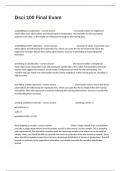Exam (elaborations)
Dsci 100 Final Exam Complete Questions And Answers For All Blocks.
- Course
- Institution
Underfitting in classification - correct answer Increased number of neighbours means that more observations are influencing the classification. This smooths out the boundaries between each class, so the model isn't influenced enough by the training data. Unde...
[Show more]



